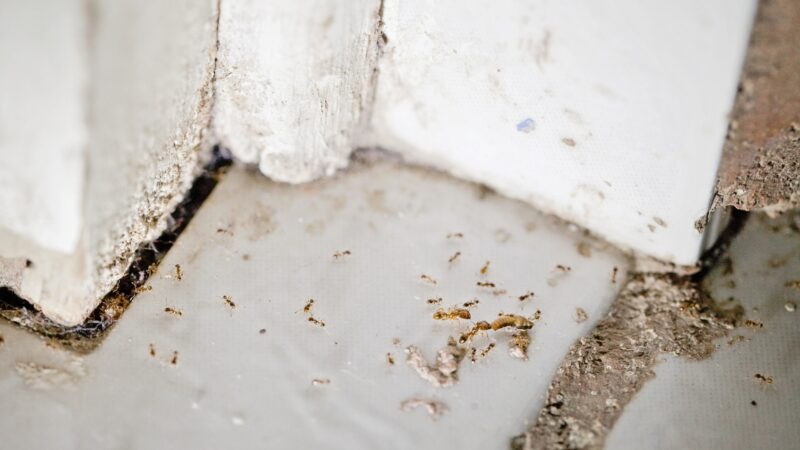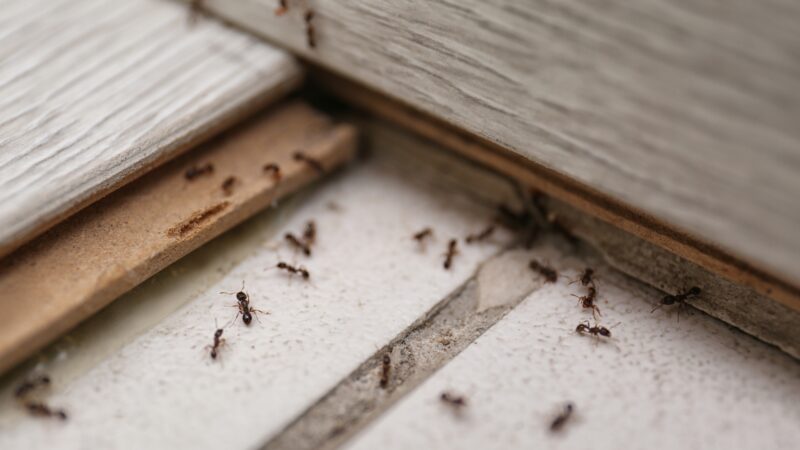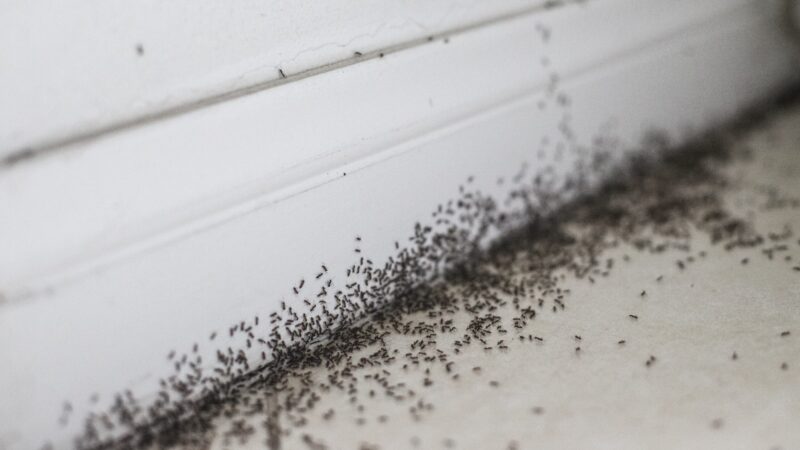The tiny ants you see on your kitchen counter are worker ants foraging for food to feed the remaining members of the colony. Their presence on your kitchen counter indicates that they have found a food source in your home and are likely to return unless the problem is addressed.
To get rid of tiny ants on the kitchen counter, you can use dish soap, essential oils, or boiling water. For more stubborn infestations, consider using diatomaceous earth or boric acid. If these methods fail, it may be necessary to hire professional pest control services.
This article covers the types of ants that commonly infest kitchens, methods for eliminating them, and tips for preventing their return. Read further for more!
Why Are There Ants on My Kitchen Counter?

Warmer temperatures in the spring and summer can increase ant activity, which may lead to increased sightings of ants indoors. At this period, workers will actively look for food to feed the colony and what better place there is than the kitchen!
Types of Ants to Look Out for on Kitchen Counters
- Odorous House Ants. Small-sized ants that are 1/16 to ⅛ inch in length with all workers being the same size, and are light to dark brown . When crushed, they release a peculiar and rotten smell, hence the name. They are attracted to food rich in sugar and other carbohydrates.
- Pavement Ants. Small ants that are ⅛ inch in length and are reddish brown. They usually build their nests along the sides of houses and garages and feed on sweet and greasy food. Unlike other ants, they prefer foraging indoors when temperatures are cold.
- Pharaoh Ants. Very tiny ants that are 1/16 inch in size and are pale to reddish brown. They are particularly hard to control since they spread and establish colonies by budding (i.e., establishing new colonies). When foraging indoors, they prefer food rich in sweets, proteins, or fats.
- Small Honey Ants. Small ants that are ⅛ inch in size and have stiff hairs present on their thorax and abdomen. They prefer sweets and honeydew from aphids but also forage for sweets in kitchens. When full of food, their abdomens become swollen. They usually build nests in well-shaded areas.
- Argentine Ant. Small ants that are ⅛ to ¼ in length and are light to dark brown. They form large colonies that may contain numerous nest locations, with ant trails reaching up to 350 feet. They can enter homes through small cracks and crevices in search of sugary substances.
Related: Ants in Kitchen | How to Get Rid of Ants in the Kitchen
How to Deal with Tiny Ants on the Kitchen Counter?

- Properly identify the ant species. This is important because the most effective control measures vary depending on the specific type of ant. For example, ant baits are effective against ants that prefer eating sweet food but do not work against ants that feed on greasy food.
- Consider your control options. You can hire professional pest control services if locating the colony of ants is difficult, or you can do it yourself if you have the time and resources.
- If you can, locate and eliminate the ant nest(s). Do so by using baits or following ant trails. If the nests are difficult to find or the baits aren’t working, caulking cracks, and crevices around your kitchen, and extensively, your home is one method of eliminating them.
How to Get Rid of Tiny Ants on the Kitchen Counter?
The best way to get rid of tiny ants in kitchen counters is to contact a pest control service since it can save you time and be more effective. However, there are also several home remedies you can do yourself too. This will be discussed in the following sections.
Essential Oils
Using a diffuser, add 10 drops of essential oils and let the device run for 1 hour or more: lavender, basil, thyme, pine, bergamot, peppermint, tea tree, and eucalyptus. You can also spray them in kitchen drawers or leave them in saucers to help keep ants away and disinfect the air.
Diatomaceous Earth
Made of silicon dioxide, diatomaceous earth is a highly abrasive substance to insect exoskeletons, drying them out and ultimately killing them. It is a registered insecticide against several pests.
Sprinkle some powdered product onto ant trails until their possible entry point. This ensures that ants trying to go towards the kitchen and back to their nests die.
Boric Acid
You can also use boric acid as the insecticidal ingredient. To do so, mix it with a food item, such as sugar or honey, then place it in a location that is out of reach of pets and children. This will lure more workers in, and before they know it, the substance will shock their bodies and ultimately kill them.
Dish Soap
Soap can’t kill tiny ants, however, it can completely erase any ant trails by covering the pheromones of tiny ants with the scent of dish soap. Simply fill up a spray bottle with equal parts dish soap or liquid detergent and water, then mist it onto ant trails.
Boiling Water
Boiling water kills tiny ants, but it will only work on a portion of a colony if not all. You have to locate their nest first then once you find it, pour boiling water all over it. It immediately kills nearly every inhabitant inside, but you may still see a few ants surviving.
Related: Do Dead Ants Attract More Ants? | The Play-Dead Phenomenon!
Are Ant Baits Effective Against Tiny Ants?

Ant baits are effective against tiny ants if you know how to arrange them. However, certain ants are not attracted to baits, so it’s important to identify the type of ant you have in your kitchen counters before creating the baits.
Ant baits work by attracting worker ants that are currently foraging for food. Once they locate the bait, they will recruit other workers and carry smaller portions of the bait back into their nest.
Afterwards, they transfer it mouth to mouth with other workers, larvae, and the queens. Since the baits have insecticides, they can effectively kill the colony’s members.
How to Use Ant Baits for Kitchen Counters?
A bait consists of an insecticide mixed with a food item, usually a sugary sweet, then placed in the kitchen counter with ant activity. Here are some tips to remember when setting up ant baits on kitchen counters:
- Placement. The bait should be placed out of reach of pets and children but not near food or areas that can easily get wet or contaminated. Do not place it near a sink, drain, or a pet’s drinking bowl.
- Amount of bait. Put enough bait and regularly check that it isn’t depleted. There should be sufficient bait for the entire colony, or they’ll continue looking in your kitchen counters for other food.
- Sanitation. Ensure the areas you put the baits in have no other food items accessible to the tiny ants, or else they’d get distracted and stray away from the bait.
- Durability. Baits will eventually age and become ineffective if exposed to rain, high temperatures, and sunlight. Replace the baits if they are no longer in acceptable condition.
- Patience. Successful baiting takes time. You may continue seeing ants a week or two after baiting since these baits are generally slow-acting. Do not kill the ants with other means, such as insect sprays, while waiting since it can contaminate the bait.
How to Prevent Tiny Ants from Coming Back?
1. Exclusion
To keep ants out of your kitchen counters, caulk or seal any cracks, crevices, and voids found around your house and along its foundations. Check wires, pipes, and other structural equipment as they also make trails on them.
2. Sanitation
Store any attractive food items in closed containers. Rinse out or dispose of any empty soft drink containers. Clean up spills and grease on your countertops and regularly remove garbage from the kitchen.
3. Habitat Modification
This involves landscaping and other activities that can lessen the chances of ants creating nests around your house’s immediate area. To do so, keep leaf litter, mulch, and vegetation a foot away from the house’s foundation. Do the same for firewood, lumber, stones, and bricks.
Related: How to Get Rid of Ants in Dishwasher | A Complete Guide
List of Sources
Alder, P., Waldvogel, M. (2018). Tips for Effective Ant Baiting.
Cornell College of Agriculture and Life Sciences. (n.d.). Ants.
Cranshaw, W. S. (2017). Ants in the Home.
Jesse, L. (2005). Ants in the kitchen.
- Bed Bug Surge 2025: How to Detect, Prevent, and Safely Eliminate Infestations in Top U.S. Cities - June 18, 2025
- Asian Needle Ants Invade US Homes: 2025 Guide to Identification, Risks, and Effective Control - June 11, 2025
- New World Screwworm Alert: How US Livestock Owners Can Prevent Outbreaks and Protect Herds [Summer 2025 Update] - June 8, 2025

